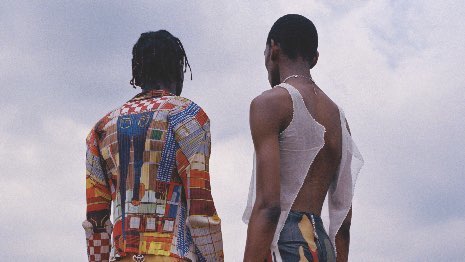- About
- Subscribe Now
- New York,
September 9, 2019

 Key to being in the black. Image courtesy of More or Less Magazine. Photography by Vicki King
Key to being in the black. Image courtesy of More or Less Magazine. Photography by Vicki King
By Duncan Gowers and Chrissy Wilson
Led by high fashion, many high-street brands are blurring the lines of race and gender. It is important and empowering.
Black culture’s dominance now leads a multi-racial acceptance that would be hard to imagine even 15 years ago.
The multi-racial power celebrities such as Cardi B, Rihanna – the first woman of color to have a maison under her own name with LVMH – and Beyoncé, their physical silhouettes and diverse shapes – the anti-size zero – have given rise to a truer sense of diversity in communications.
Color bind
In the United Kingdom, at high-street level, brands such as boohoo and Missguided’s astronomical success is not simply because of the low price point of product and wide range, but because the advertising and ecommerce imagery blurs the lines of common fashion advertising practice.
These brands do not just present the customer with a diversity of size and shape, but also ethnically blur lines between black, white, Asian and beyond, all combined to communicate a powerful acceptance of self, where beauty is acknowledged and celebrated regardless of race or body shape.
In the United States, brands such as the Khloe Kardashian-fronted Good American similarly speak to a blurring of ethnicity, shape and confidence with African-American, Latin, mixed-race and white models, influencers and customers. This true diversity stems from the melting pot of black street culture and its openness to change, progress and evolution.
What fashion does not do is solve the issues of inequality, institutional racism, or all negative viewpoints. What it does do, however, is give rise to the notion of ownership and auteur rights.
Brands that continue fashion faux pas when it comes to black culture are almost immediately castigated as, if not racist, then woefully out of touch. Any appropriation, which remains unfortunately a domain of fashion still yet to be erased, is unacceptable.
One African-American designer that beautifully encapsulates the idea of ownership and postmodern curation is Jerry Lorenzo.
As founder of Fear of God, Mr. Lorenzo repackaged motifs traditionally associated with white culture – punk, heavy metal and grunge, and reasserted them for a contemporary elite black audience.
Starting with vintage band T-shirts, deconstructed and distressed denim, Mr. Lorenzo used a network of musicians and athletes to express his vision.
When the hoards of mimics began copying his oeuvre, he evolved his vision further, creating high-end leather hi-tops, a baggy, post-apocalyptic collection and even an homage to his baseball-manager father, all fused by a connection to African-American cultural totems such as religiosity, the street, hip hop and sport.
Mr. Lorenzo’s latest collection is a collaboration with Nike, where Fear of God has created a distinct, iconic basketball shoe, goes even further, blending a new vision of black fashion and culture with its most visible athletic playing field. The plaudits continue to rain down.
New wizards
When Virgil Abloh, a former architecture student and creative consultant to Kanye West, launched his premiere menswear collection for Louis Vuitton’s Spring ‘19 show, the significance of the moment could not be underestimated.
For the first time in history, a man of African heritage stood atop the mountain of elite fashion influence and importance. His “Road to Oz” show was what Tim Blanks called “a spectacular visual representation of harmonious human diversity underwritten by LVMH.”
It was an arrival and a statement: an apex of diversity and inclusion in fashion.
Recently it was announced that Rihanna would disrupt the status quo – not with a new album, but by teaming up with LVMH to launch her own maison.
Not only is it the first new house created by the group since Christian Lacroix in 1987, but she is the first woman of color at the top of an LVMH maison.
This is further acknowledgement that the luxury business does not just need old names reinvented – times they are a’changing, and not only do pop stars/actresses such as Rihanna carry as much currency and influence as designers but they also help the luxury industry move forward and embrace a digital-savvy audience.
The only way for brands, who themselves may be traditional “white” European fashion and luxury houses, to truly connect with black culture is equal footing.
Creative control, cultural viewpoint, artisanship, co-creation. These are the benchmarks for inclusion in the black designer’s world.
THROUGH MUSIC, street and popular culture, all facets of fashion have been inspired by black culture. And not just through garments or designs, but also questions of ownership.
Now black designers have agency over their perspective on culture through fashion.
The pioneers we laud, like Mr. Abloh, are auteurs. It is their singular vision that is expressed with an undeniable and urgent potency.
From The Wednesday Report, Summer 2019, produced by the Wednesday Agency Group.
Duncan Gowers is director of strategy and content at Wednesday Agency, London. Reach him at duncan@wednesdayagency.com. Chrissy Wilson is executive assistant to the president of Wednesday Agency in London. Reach her at chrissy@wednesdayagency.com.
Share your thoughts. Click here